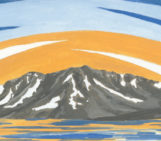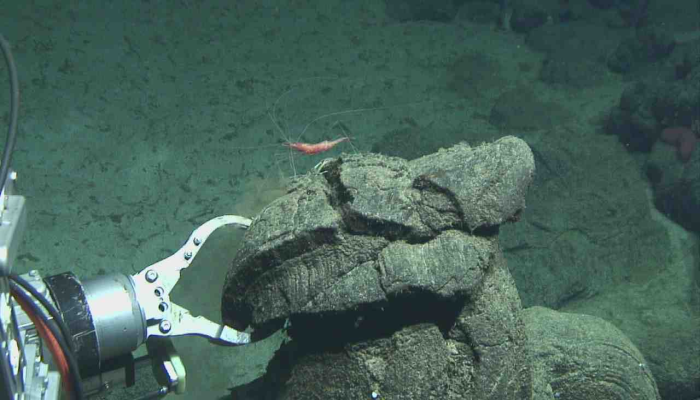
As geodynamicists, we are sometimes oblivious on how we get the geophysical constraints in our numerical models. This week Molly Anderson, a PhD student at the University of Florida, takes us on a exciting dive to study the geochemical signatures of the East Pacific Ocean seafloor!
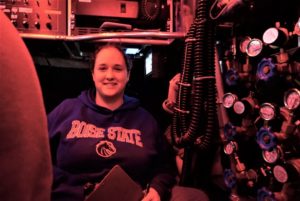
Molly Anderson during her first dive in Alvin to study seafloor volcanoes (seamounts) near the East Pacific Rise. © Michael Perfit
People are often surprised to hear that the seafloor is covered with volcanoes, let alone that the most extensive chain of mountains lies beneath our oceans, circling the globe and forming most of Earth’s crust. Each year, scientists venture down to these mountains and seafloor volcanoes to address questions like “How is life sustained without the presence of sunlight?” or “What is the composition of Earth’s upper mantle?” I study the latter question using samples of basalt lava collected in-person with the HOV (Human Occupied Vehicle) Alvin, coupled with high-resolution (up to meter-scale) bathymetric mapping by the AUV (autonomous underwater vehicle) Sentry. Basalt magmas form from partially melting Earth’s mantle, and therefore provide important windows into Earth’s interior over time. Our lab group uses the compositions of seafloor basalts to constrain the extents to which the suboceanic mantle partially melts, or the depths at which magmas cool and evolve in magma chambers, ultimately revealing the chemical and dynamic processes responsible for generating oceanic crust at an astounding rate of ~ 19 cubic km globally per year.
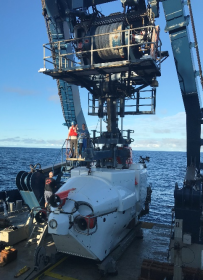
Molly Anderson waves to scientists and crew onboard research vessel Atlantis before climbing into Alvin for her first dive near the East Pacific Rise. Michael Perfit climbs the stairs to lead the dive as primary scientist. © Valentina Romano
My first dive in Alvin to study a chain of volcanoes near the East Pacific Rise spreading center was unlike any other experience in my life. The night before, I prepared a pillowcase with several pairs of thick socks, sweatpants, a sweatshirt, and a voice recorder for the dive. Despite near-equatorial tropical temperatures at the surface, Alvin’s interior approaches the near freezing temperatures of the ocean that exist at great depths after 6 to 8 hours on the seafloor. We were prepared for the cold.
After waving to fellow scientists and crew onboard Atlantis (the research vessel that houses Alvin), we climbed into the titanium sphere, which was then sealed to maintain atmospheric pressure throughout the traverse to the seafloor. The trip to the bottom began with peering out the windows at a gradually fading blue light into a darkness lit only by the valiant flicker of bioluminescent microbes responding to our presence in their water column. To conserve power on the descent, the exterior lights were turned off, and I found myself in those first two hours surrounded by darkness, trying to comprehend the immensity of 2800 meters of water above my head and my study area finally within reach below. I had been studying the compositions of lavas from these volcanoes for years, had pored over the maps and the images from prior expeditions to the East Pacific Rise, and had daydreamed of one day becoming an ‘aquanaut’… but nothing prepared me for the moment Alvin’s lights flicked on, illuminating the volcanic seafloor never before seen or touched by humankind.
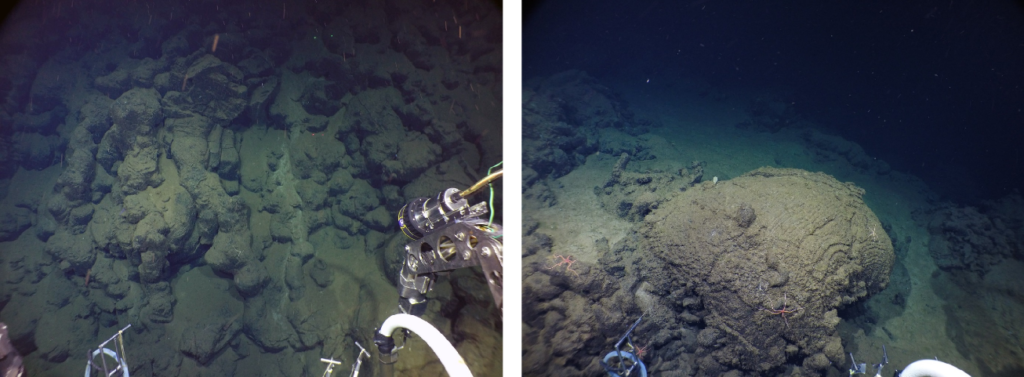
Pillow basalt outcrops at about 2800 meters depth near the East Pacific Rise. © Woods Hole Oceanographic Institution with thanks to Daniel Fornari (WHOI-MISO Facility) and National Science Foundation.
Salmon-pink shrimp danced past the acrylic windows as sediment stirred up settled around us to reveal a steep wall of truncated pillow basalts; we had landed facing the shear wall of a fault. Over the course of 6 hours, we slowly ascended the flank of the volcano, scouting for various rock outcrops and describing the geology and flora and fauna along the way. We mumbled descriptions of the scenery into voice recorders, as it proved difficult to peel oneself away from the mesmerizing windows to write things down. Hovering mere meters from the seafloor, cameras beneath Alvin revealed a dumbo octopus majestically flying through the water past a vibrant, neon-purple sea cucumber. Knowing where to look became a challenge as the seafloor unraveled its mysteries all around us. Rolling flows of Prius-sized basalt pillows emerged along the horizontal flats while elongate basalt tube flows sprinkled with sediments stretched vertically down the volcano flanks. Dr. Seuss-like bulbous, white sponges clung to the basalts and delicately swayed in the current.
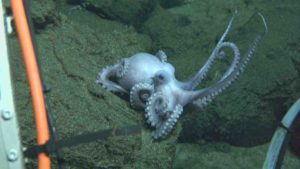
Muuscoctopus on a pillow basalt around 2800 meters depth, interacting with the hydraulic arms of HOV Alvin. © Woods Hole Oceanographic Institution with thanks to Daniel Fornari (WHOI-MISO Facility) and National Science Foundation
We periodically stopped to collect and document rock samples using Alvin’s hydraulic arms, or slurped up crustaceans for the biologists who eagerly waited at the surface for signs of deep-sea life. Near the end of our dive, we approached a basalt pillow with exposed ridges perfect for sampling, and were greeted by a violet Muuscoctopus. Rather than hide from what may have been its first exposure to light, it remained on the rock outcrop, curious about the beams of light emanating from Alvin. It unraveled and flexed its tentacles, eyeing us suspiciously as we collected a basalt from its host outcrop. Within minutes and far too soon, we were alerted it was time to ascend and leave the wonders of the deep behind.
Our return trip to the surface was full of excitement, an overdue lunch, and detailed calls back to the ship relaying information about what we found at the bottom. The scientists and crew at the surface prepared for our arrival with buckets and sample labels, rock saws and microscopes. We would immediately process and examine our rock collection onboard, in preparation for detailed geochemical analyses that would prove useful for probing the composition of Earth’s interior.
To this day, I continue to analyze the samples we collected from my first dive in Alvin and find I am occupied with more questions than answers about Earth’s interior dynamics. With each sample, we are refining models for oceanic crustal formation and mantle dynamics in ways once unobtainable without deep-sea exploration. Recent upgrades to Alvin over the past year will soon enable scientists to dive deeper than ever before. Previously, Alvin was optimized for dive depths up to 4,500 meters, but Alvin is currently undergoing testing to depths up to 6,500 meters. This major feat in deep-sea exploration means that now 98% of the seafloor will be accessible by scientists. With this upgrade and with results from prior dives with tantalizing hints of Earth’s interior complexities, we anticipate future opportunities to learn even more about the processes responsible for forming oceanic crust and the longest chain of mountains on the planet.

